CHP 5 Weathering and Soils
1/66
There's no tags or description
Looks like no tags are added yet.
Name | Mastery | Learn | Test | Matching | Spaced |
|---|
No study sessions yet.
67 Terms
Weathering, Erosion, and Transportation
-Earth's surface is constantly changing
-Rock disintegrates and decomposes-weathering (links to rock cycle, systems)
-move to lower elevations by gravity or eroded away. by water, wind or ice
-Sculpting Earth's physical landscape
- These processes affect the composition of the Earth's atmosphere and produce soil
-Responsible for deterioration of many structure we build
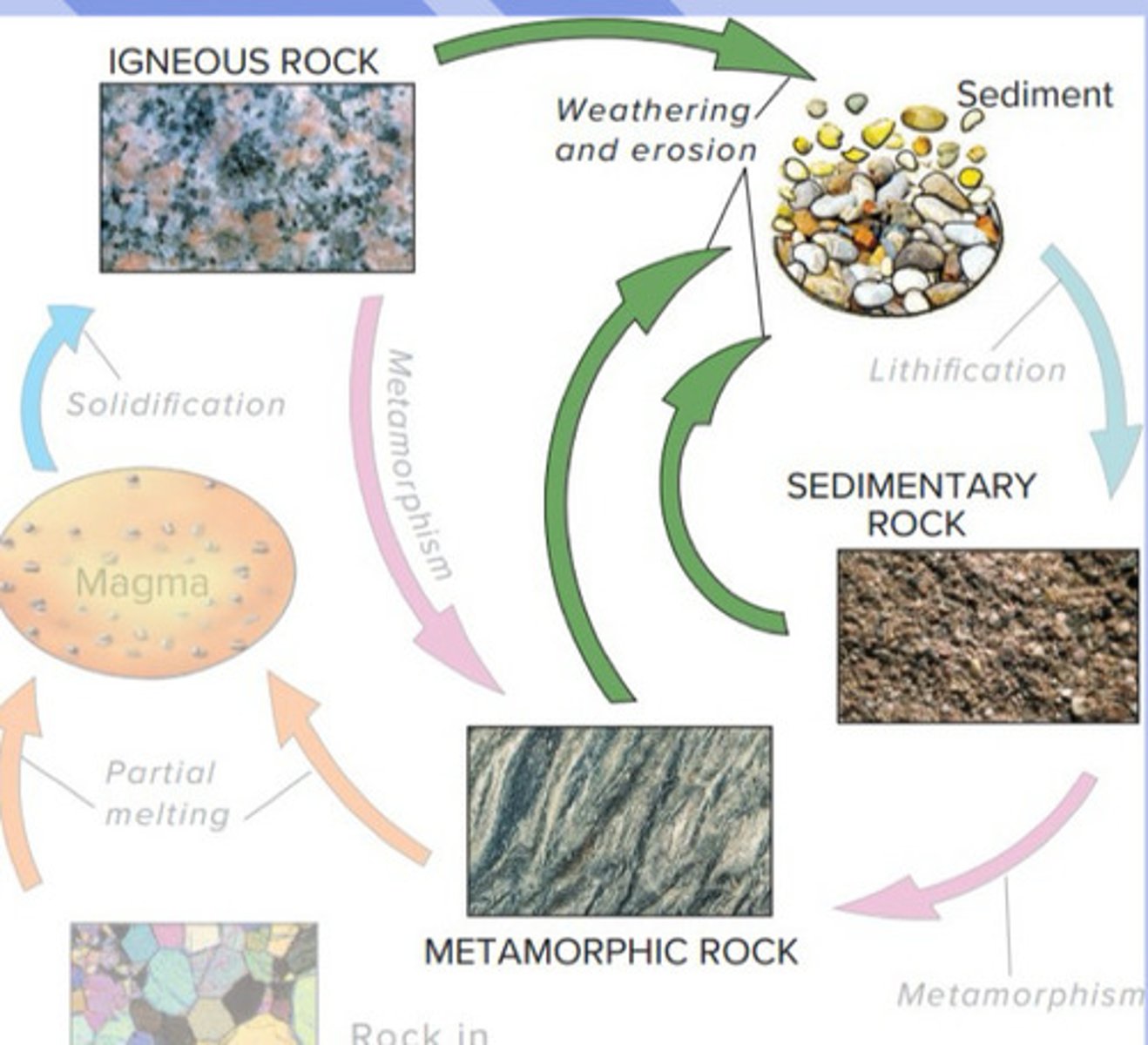
Rocks exposed at Earth's surface are constantly changed by water, air, temperature variations and other factors-weathering
Rocks exposed at Earth's surface are constantly changed by water, air, temperature variations and other factors-weathering
Weathering
The group of destructive processes that change the physical and. chemical character of rocks at or near Earth's surface-prepares rock for erosion and transportation
Erosion
a physical picking up of rock particles by water, ice, or wind
Transportation
the movement of eroded particles by water, ice , or wind
mechanical weathering
Processes that break rocks into smaller pieces without changes to the chemical composition
Chemical weathering
decomposition of rock from exposure to water and atmospheric gases(carbon dioxide, oxygen, and water vapor)
Effects of Weathering
-Destruction of building materials
-Discoloration of surface outcrops
-Production of soil
-Impacts the atmosphere(removes carbon dioxide)
-Creates interesting and unusual rock shapes(spheroidal & Differential)
Spheroidal weathering
occurs where rock has been rounded by weathering from an initial blocky shape. Chemical weathering occurs more rapidly at the corners than along the edges

Differential Weathering
Rocks weather at different rates
ex: Shale (composed of soft clay minerals) tends to weather and erode faster than sandstone (made of hard quartz minerals)
Mechanical Weathering: Pressure Release
Breaks into smaller and smaller pieces, each retaining the characteristic of the original material
4 physical processes leading fragmentation
-Pressure release or joining & sheeting
-Frost wedging
-Salt crystal growth
-Biological activity
pressure release
removal of overlying rock(unloading) allows expansion and fracturing (sheet joints).
JOINTS BREAK LOOSE IN CONCENTRIC SLABS
JOINTS BREAK LOOSE IN CONCENTRIC SLABS
Frost action
mechanic effect of freezing (and expanding) water on rocks. Ex: Frost wedging and Frost heaving
frost wedging
The mechanical breakup of rock caused by the expansion of freezing water in cracks and crevices
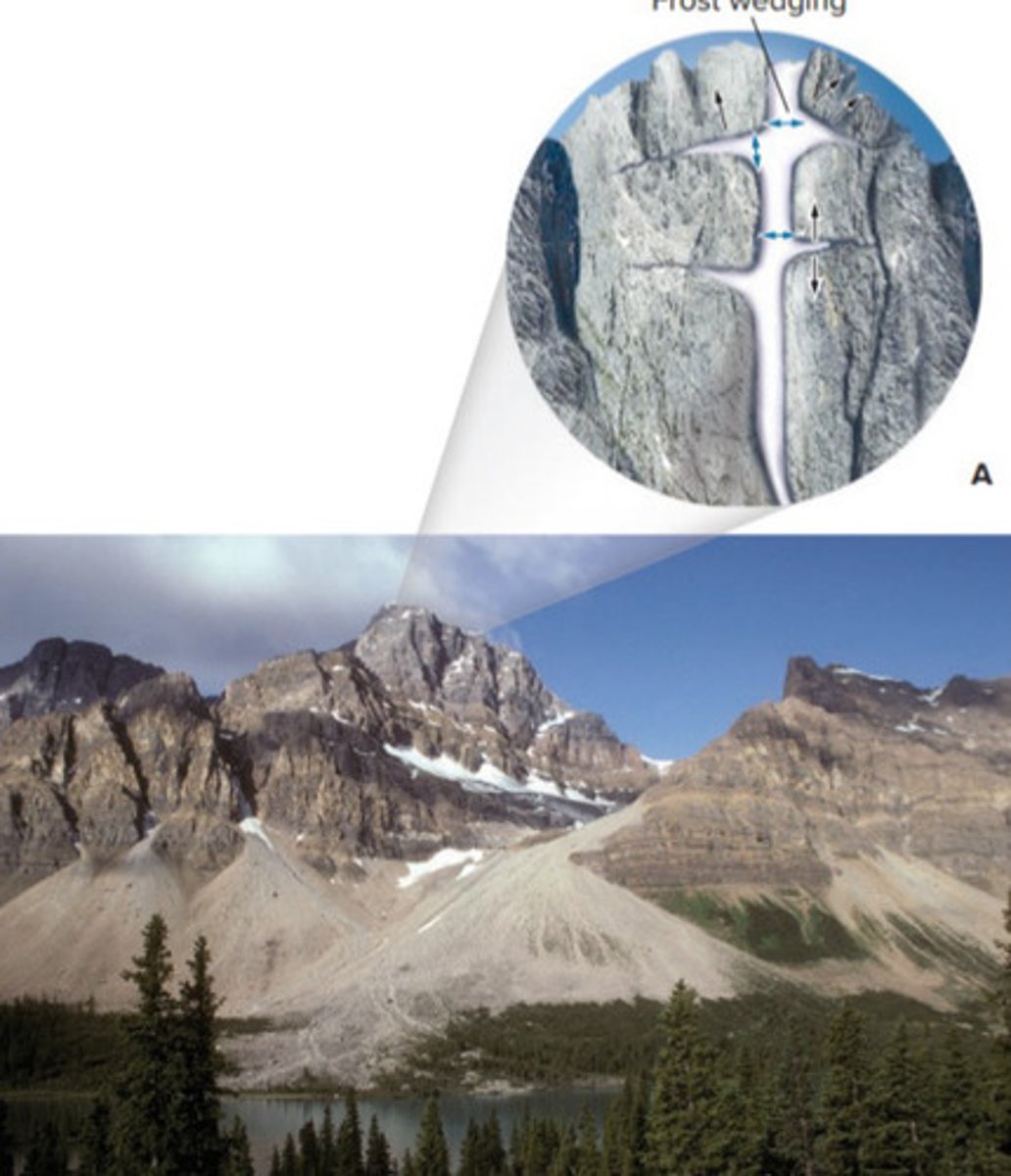
frost heaving
The lifting of rock or soil by the expansion of freezing water.
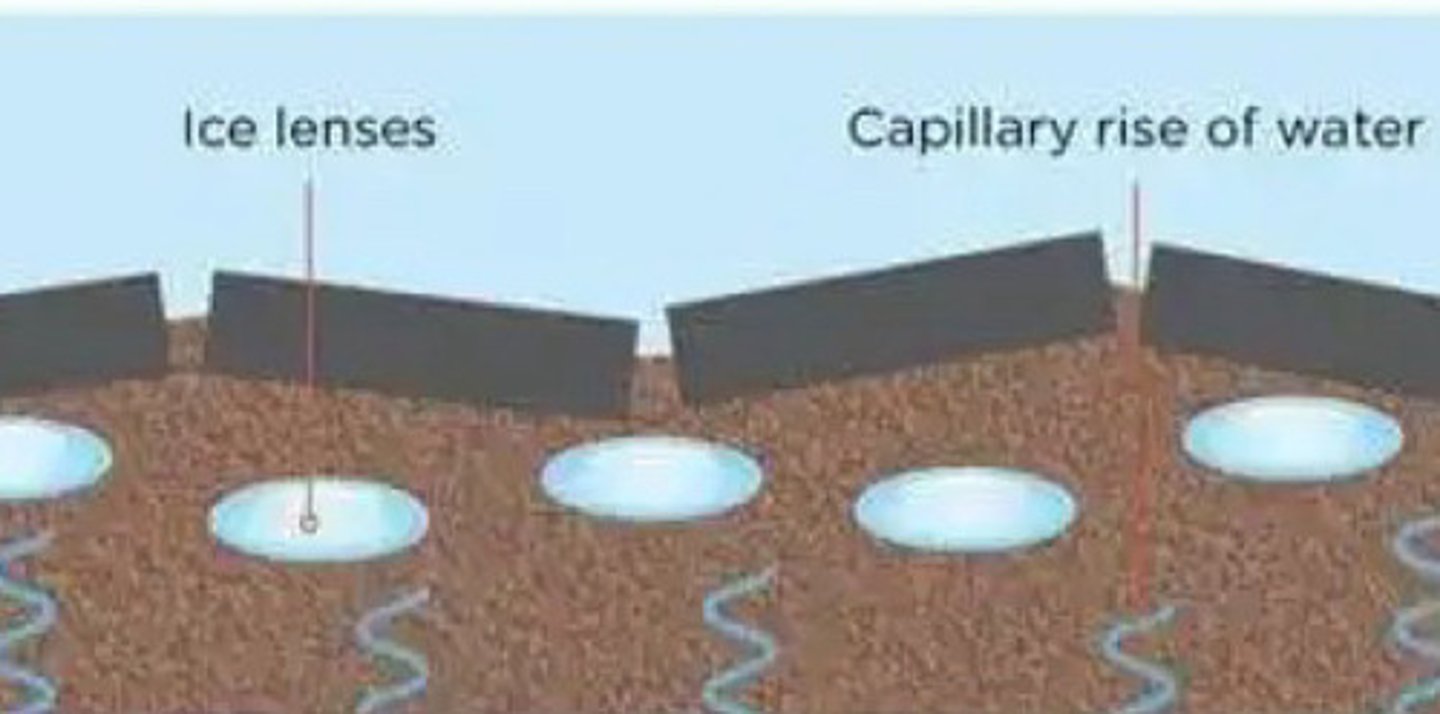
Other Types of Mechanical Weathering
-Biological Activity(plant growth, burrowing animals)
-Thermal variation
-Salt pressure
Plant growth and mechanical weathering
growing roots widen fractures
Thermal Variation
Larger temperature changes fracture rocks by repeated expansion and contraction
ex:desert, forest fire
Salt Pressure
Salt crystal growth as water evaporates in cracks
As mechanical weathering breaks rock into smaller pieces, more surface area is exposed to chemical weathering.
As mechanical weathering breaks rock into smaller pieces, more surface area is exposed to chemical weathering.
Chemical Weathering
-complex breakdown of rock components and internal structures of minerals
-New minerals are formed and may be released to the environments
-This decomposition converts the original rock into substances that are more stable in the surface environment
Main Process of Chemical Weathering
-Dissolution
-Oxidation
-Hydrolysis
(Chemical Weathering Oxygen & Acid)
Role of Oxygen/Oxidation
Chemically active oxygen from atmosphere.
• Iron oxide stains are common result.
(Chemical Weathering Oxygen & Acid)
Role of Acids
hydrogen cations replace other in minerals
Chemical Weathering Oxygen & Acid
- Carbonic acid from atmospheric CO2 dissolved in water, most important source of acid
-Sulfuric, hydrofluoric acids emitted by volcanic eruptions
-some minerals such as calcite may be dissolved by the weak acid
-Human activity such as mining and burning of fossil fuels, produces acids.
Weathering the carbon cycle and global climate
-Present in the atmosphere as carbon dioxide (CO2)gas
-CO2 combines with water to form carbonic acid
-This acid weathers rocks and leads to limestone formation in bodies of water -This product of weathering is returned to mantle by tectonic plate movement
-The CO2 is released back to atmosphere by volcanic eruptions
-The CO2 in the atmosphere impacts global temperature
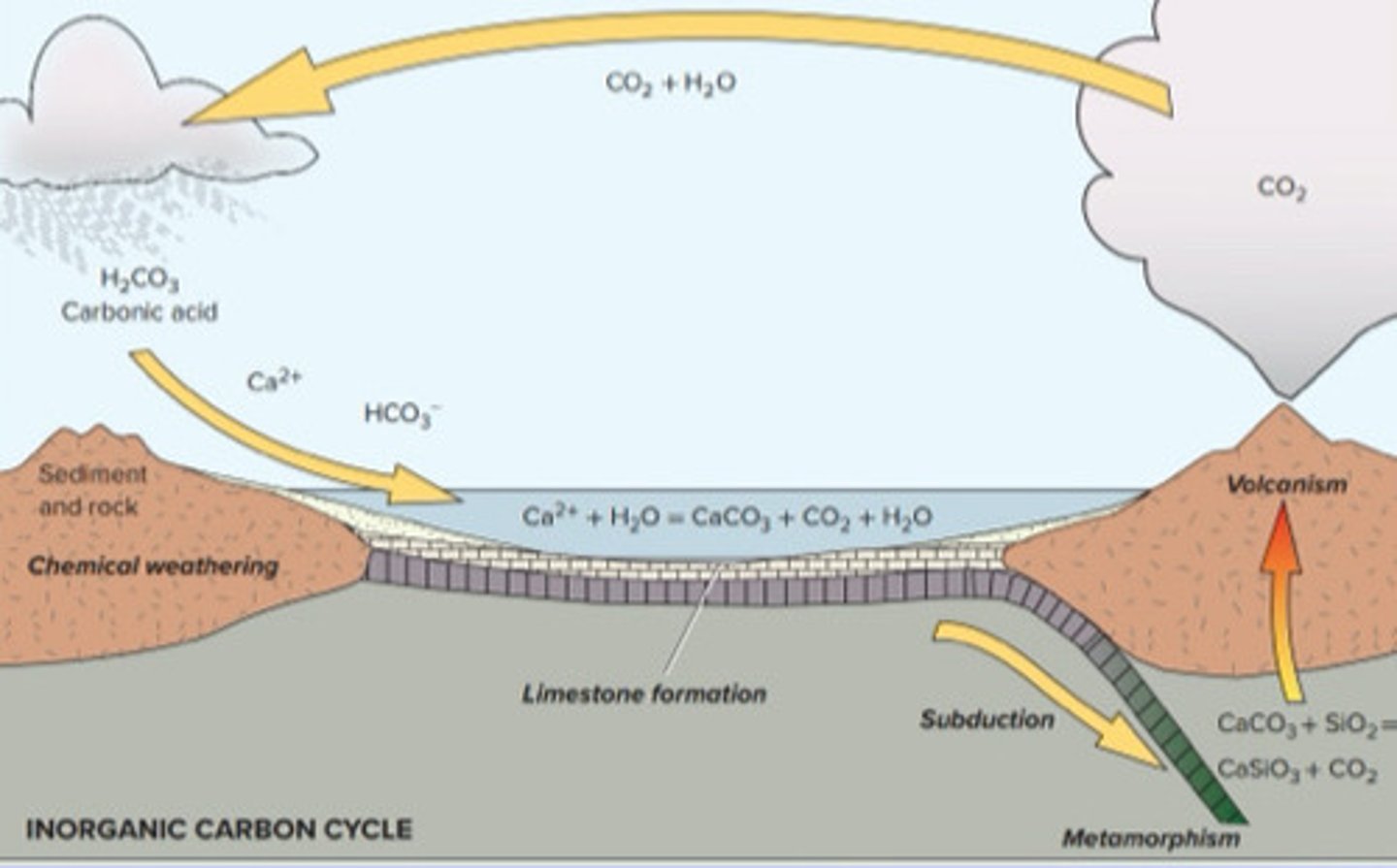
Chemical Weathering of Feldspars
- most common minerals in crust.
- slightly acidic rain water attacks feldspar.
- clay minerals produced are structurally different from the feldspar rock
Chemical weathering of other minerals
-similar to feldspars, creates clay minerals and dissolved ions
-More complex silicate bonds lead to lower weathering susceptibility
weathering products
-soil is one of the most important products of weathering
-Feldspar and ferromagnesian mineral weather into clay releasing ions in solution
-quartz weathers into sand and silt to ions released
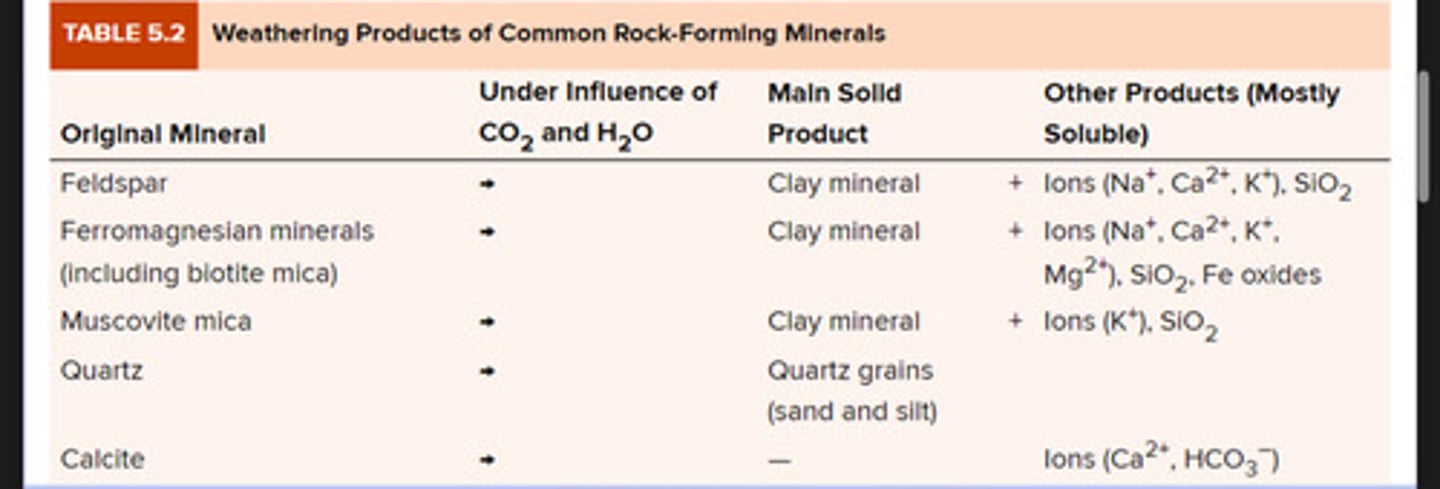
Weathering Products
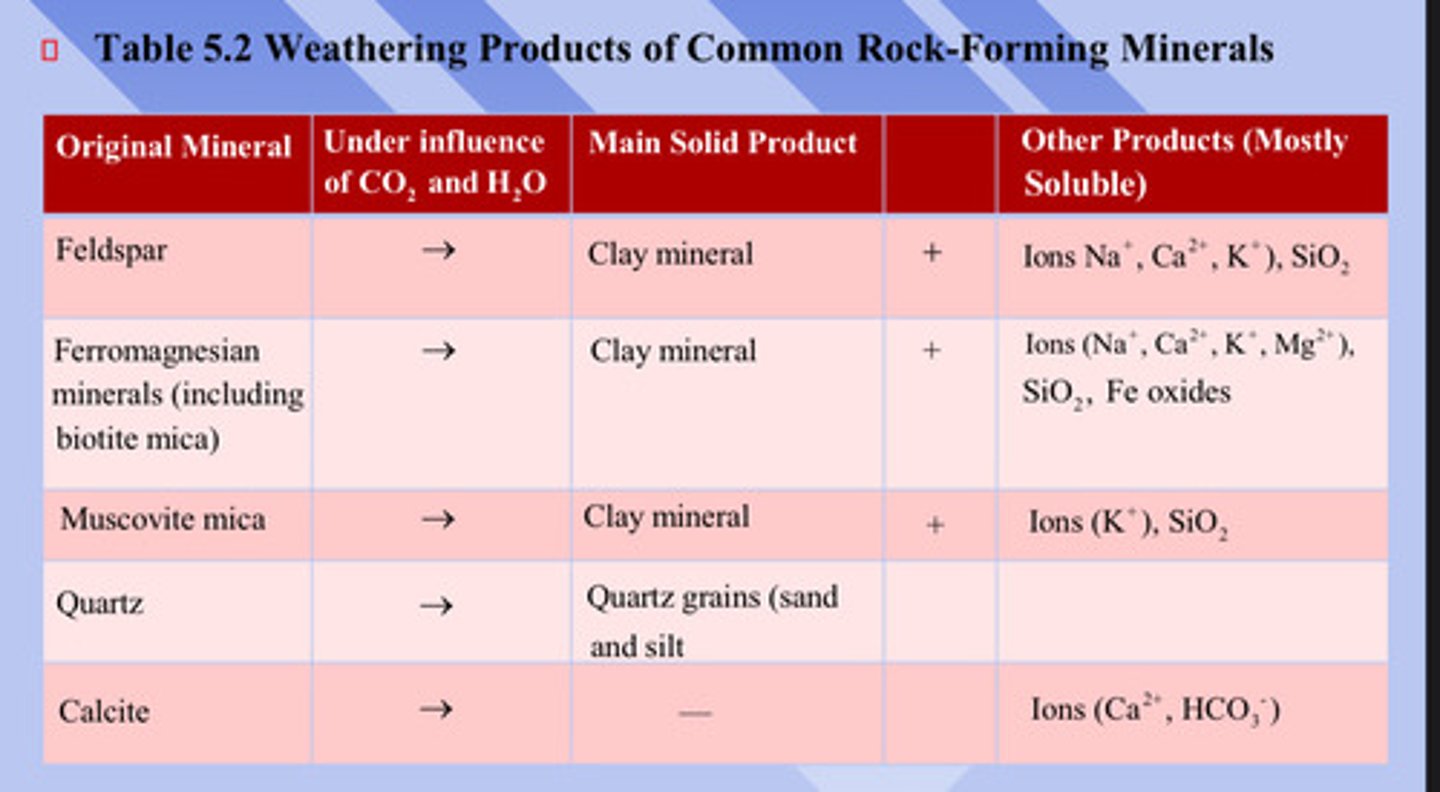
SOILS ARE OFTEN DEFINED IN THESE TERMS AS "DYNAMIC NATURAL BODIES'' HAVING PROPERTIES DERIVED FROM THE COMBINED EFFECTS OF CLIMATE AND BIOTIC ACTIVITIES
SOILS ARE OFTEN DEFINED IN THESE TERMS AS "DYNAMIC NATURAL BODIES'' HAVING PROPERTIES DERIVED FROM THE COMBINED EFFECTS OF CLIMATE AND BIOTIC ACTIVITIES
Soil
a layer of weathered, unconsolidated material on top of bedrock capable of supporting plant growth and the common soil constituents (clay minerals, organic matter, water, and quartz)
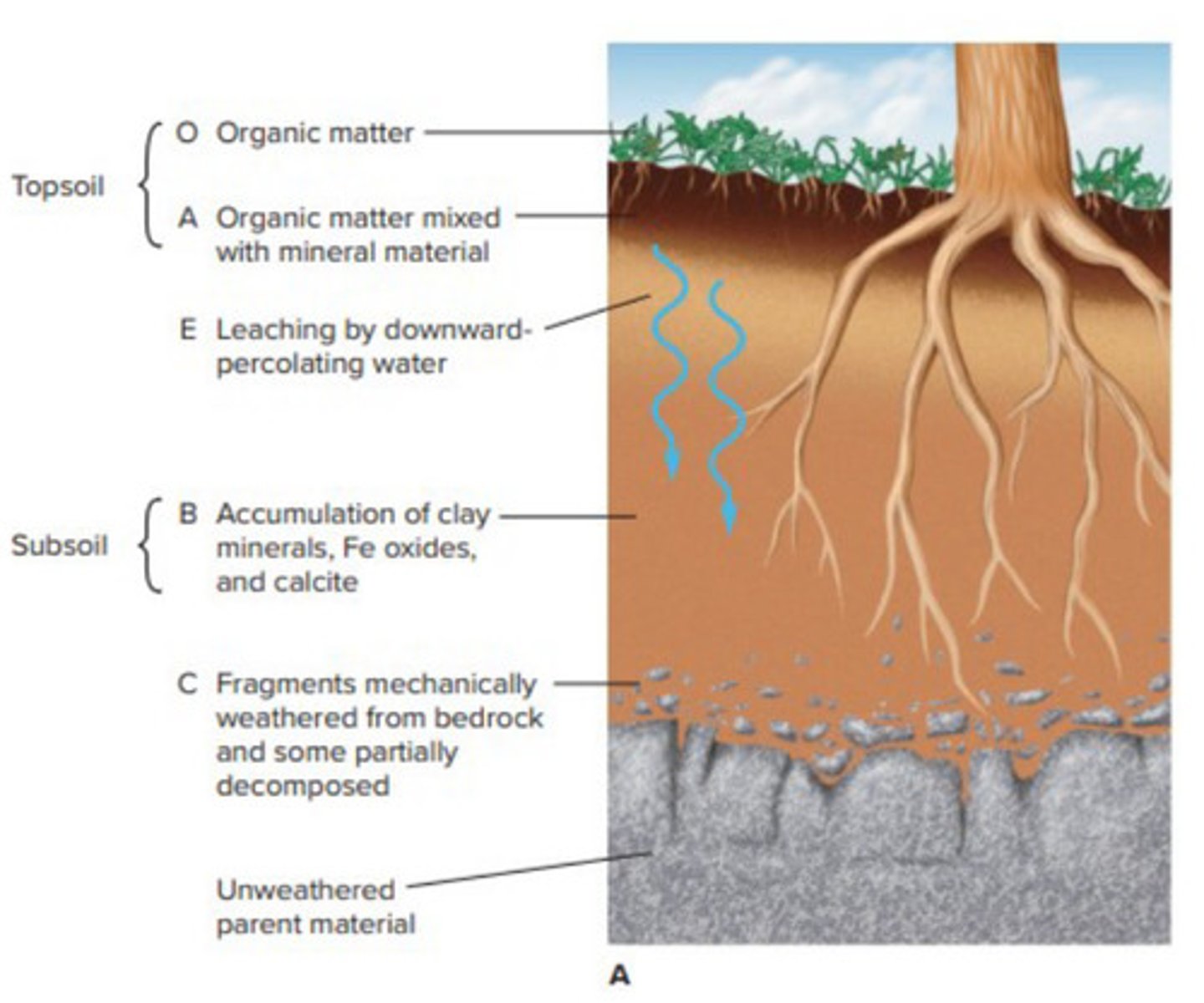
Pedon
a 3-D unit that represents the entire soil body and is the smallest volume of soil that shows all the characteristics/properties of a particular soil
-typically represent 10-100 sq ft of surface area
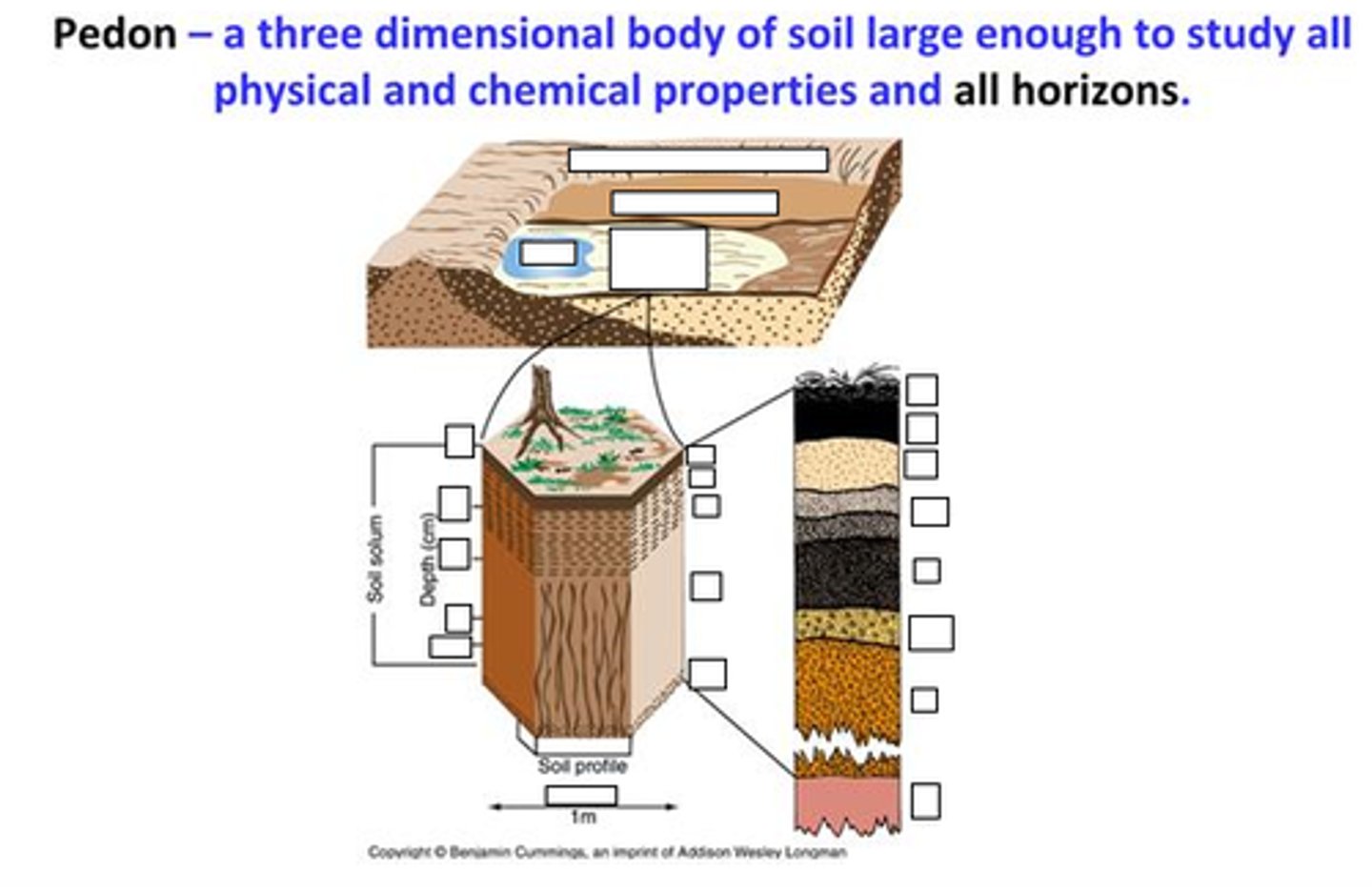
Polypedon
a group of pedons
Horizonation
process of formation of soil horizons
-results from differential gains, losses,tranformations, and translocations occurring over a period of time
Soil Horizons
O horizon-uppermost layer, organic material
A horizon-dark-colored, rich in organic matter and high in biological activity
E horizon-zone of leaching; fine grained material removed by percolating water
B horizon- zone of accumulation; clays and iron oxides leached down from above; formation of hard pan in wet climates
C horizon- partially weathered bedrock
Soil Formation
Most soils are derived from sediments that are transported by water, ice, and wind and gravity
General Order:
Rock(at a topographic site)-->PM
PM+Biotic Factors+Time-->Soil
factors of soil formation Hint:5
1) Parent material (PM)
2) Climate:rainfall and temperature result in weathering
3) Living Organisms ( specifically vegetation & human activity)
4) Topography/slope
5) Time
(Factors of Soil Formation)
Parent material(PM)
-Nature of parent material
A. Texture and Structure
B. Chemical and Mineralogical Composition
-PM includes glacial deposits, alluvial and marine deposits, residual minerals and rocks
(Factors of Soil Formation)
Climate
rainfall and temperature result in weathering
(Factors of Soil Formation)
Living Organisms
-The type of vegetation affects the soil color and organic matter content, especially in the A horizon
-Trees contribute less organic matter to the soil each year when compared to grasslands.
(Factors of Soil Formation)
Topography *3 parts*
-Elevation-the height above mean sea level
- Slope- the tilt or inclination of the land
- Aspect-the direction the slope is facing
Soils on a steep slope
-when lopes increase soils become shallower, thinner, and have fewer horizons
Why:THE STEEPER THE SLOPE THE GREATER THE RUNOFF AND THE GREATER THE EROSION
(factors of soil formation)
Time
Important in soil formation because it determines the degree to which the other soil forming factors express themselves
Old soils
Soils that experienced intense weathering of parent material in the presence of biotic factors
-well developed profiles
-contains A,E,B horizons
Young Soils
Have weakly developed horizons and may often lack E &B horizons
-lacks horizon development
THE O AND A HORIZONS ARE THE MOST VALUABLE AND THE MOST VULNERABLE TO EROSION
THE O AND A HORIZONS ARE THE MOST VALUABLE AND THE MOST VULNERABLE TO EROSION
How Soil Erodes
-Soil particles are small and are therefore easily eroded (carried away) by water and wind
- water erosion is the most significant type; wind erosion is generally less signifigant.
Rates of Erosion
soil characteristics, climate, slope, vegetation
Consequences of Erosion
- Removal of an essential resource
- Sedimentation of water bodies
Categories of the System(divisions)
1) Orders
2) Suborder
3) Great group
4) Subgroups
5) Families
6) Series
-Grouped based on characteristics of the horizons in the soil profile
Soil orders
1) Entisol (ent)
2) Inceptisol (ept)
3) Spodosol (od)
4) Alfisol (alf)
5) Aridisol (id)
6)Mollisol (oll)
7) Ultisol (ult)
8) Vertisol (ert)
9) Histosol (ist)
10) Oxisol (ox)
11) Andisol (and)
12) Gelisol (el)
World Soil Orders
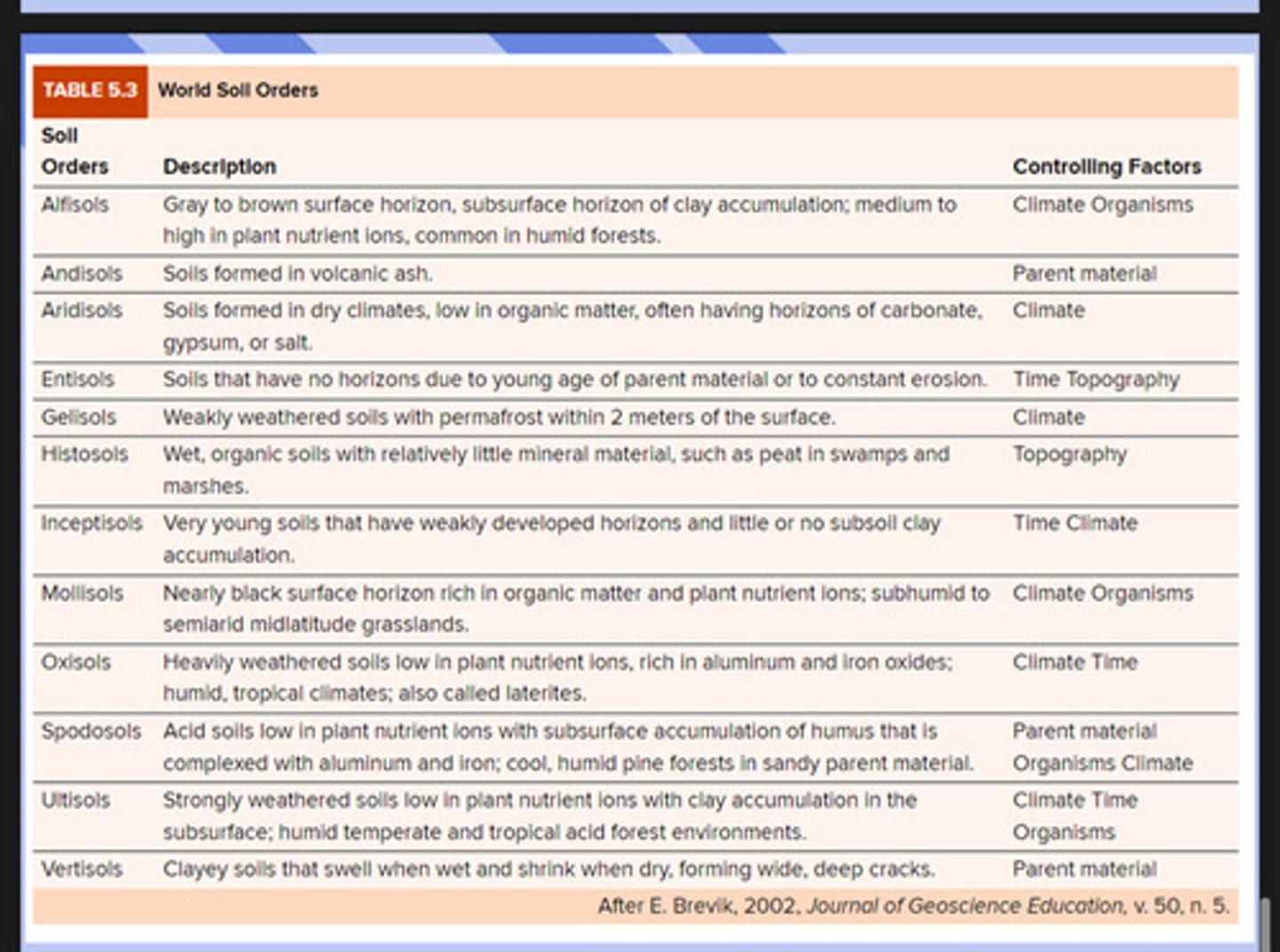
Entisols (ent)
soils of recent origin an not developed
-occurring as unconsolidated parent materials (sediments and rocks) with no horizons except an A horizon
-found in diverse environments, in steep, rocky settings
-most diverse and most common soils
Utisol
-high contents of aluminum and iron oxides
- soils in wet climates of Southeastern U.S. and Europe
-soil tends to be thick
Oxisols (ox)
-In tropical regions (high temp abundant rainfall)
-soil tends to be highly leached
- soils are called Laterities
Laterites
A red, highly leached soil type found in the tropics that is rich in oxides of iron and aluminum (Oxisols)
-generally nonproductive soil
- If aluminum content is high it forms aluminum ore bauxite
Hardpans
a soil layer that has become hardened through the cementation of soil particles with organic matter or other naturally occurring soil chemicals that root penetration and water movement are restricted
How are hardpans formed?
In wet areas when clay minerals, silica, and iron compounds accumulate in the B horizon eluviation (leaching dissolved and suspended materials) from the overlying E horizon and harden, hardpans are formed
*hardpans are difficult to penetrate and prevent root development*
Leaching
removal of dissolved materials from soil by water moving downwards
Eluviation
the washing out of fine soil components from the A horizon by downward-percolating water
aridisols
-arid dry climate in western U.S.
-soils tend to have very thin and have very little organic matter
-water in this soils moves upward and contains high levels of salt
-when water beneath the surface evaporates it precipitates and leaves salt within the soil
-very alkaline
-some of these soils build up high levels of calcium and are called pedocals
Pedocals
Soils formed in dry and temperate climate; rich in calcium carbonate
Afisols
In the temperate areas of the U.S with moderate rainfall, soils which form have moderate levels of iron and aluminum and called pedalfers.
Pedalfers
Soils formed in humid, temperate climate; rich in iron-oxide and aluminium oxide; reddish-brown color